Unique is Good – For Asclepias Monarch Promise
I’ve long debated highlighting Asclepias curassavica Monarch Promise for two reasons. First, it’s only cold hardy south of Zone 10 (9b in a warm winter). However, why the heck not just grow it as an annual – I have a friend in Montreal who adores this plant and it looks even better up north! Second, the native plant purists will probably want to stone me – but down here in Georgia we hoard ammo so that doesn’t really worry me either.
With that being said, the green form of Asclepias curassavica is a pretty amazing, reblooming, tough-as-nails plant in the landscape. At 3- to 4-ft. tall, its flowers attract everything with four wings (and some two-winged critters, too) due to flowers with deep reddish-orange outer corollas (buds) and vivid orange to yellow corollas. With that being said, the variegated cultivar Monarch Promise adds a whole next level of gaudiness to this plant that makes it a must have for this gardener. It should also be a must have for other gardeners who are looking for tough pollinator plants.
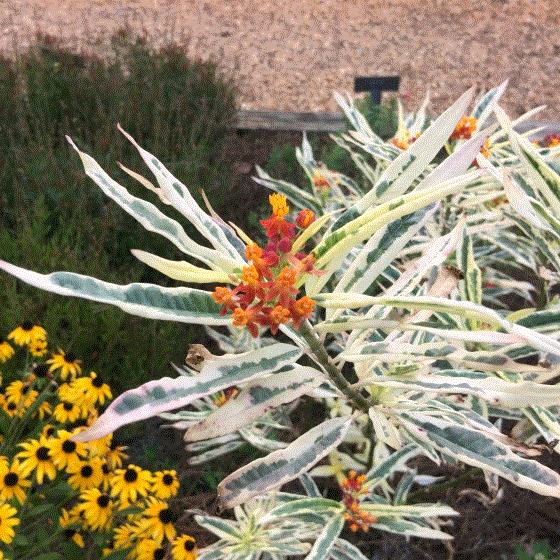
It's tough to beat variegated and super red/orange/yellow floral displays. Thanks, Asclepias curassavica Monarch Promise!!It's
And for those who worry that it reblooming late in the season will hamper butterfly migration, there's a solution for that. It’s simply removing all growth about a month before the typical first frost. Viola… problem solved. Ain’t induced dormancy grand?
2017 – A Bad Hurricane Year for Producers?
I’ve heard several “experts” recently state that 2017 may go down as the “worst hurricane season on record.” While absolutely true based on nationwide economic losses, it made me wonder what some of the worst years have been for nursery producers. I looked back over the last 25 years, and while every year has had a bad storm for someone somewhere, the truly memorable years are much less frequent.
By far the worst year for many nursery growers along the gulf coast was 2005, when Dennis, Katrina and Rita devastated the nursery industry from Alabama to east Texas. This was an especially bad year for those along the Alabama/Florida panhandle coasts because just a year earlier, in 2004, a doozy of a hurricane in Ivan wrecked the Alabama and west Florida coast. But 2004 also featured a surprise (as far as intensity is concerned) Hurricane Charley, too, as well as Frances. In general, 2004 was not a good year for Florida producers. And speaking of bad years for Florida, if you'd been downloaded onto the planet, you probably remember Andrew in 1992, which remains a benchmark for damage to both residential and commercial agriculture properties in the U.S. from a single storm.

Flooding can be the worst possible natural disaster for a nursery, as it results in major losses (as in disappearance) of plants. This is especially true in medium-sized containers. Photo courtesy of the North Carolina Nursery & Landscape Association, 2016.
The Mid-Atlantic can’t be ignored either, with two particular years being memorable. The first was 1999, when flooding was the biggest issue for growers (yes – pots will float away). Hurricane Dennis was closely followed by Hurricane Floyd, which inundated the grower-heavy area of eastern North Carolina and eastern Virginia. The second was just last year (2016) as Hurricane Matthew caused significant damage in the same areas hammered in 1999.
How will 2017 stack up against these “peak” years? An argument can be made that as bad as this year has been for property damage, it's been an average-to-below-average year for nursery (woody ornamental) damage. South Florida foliage growers took it on the chin with Irma and several Texas growers were innundated by Harvey, but so far the nursery industry has avoided widespread event. That's not to say a lot of pots have been picked up in the last month. I think most growers will take that, especially when seeing the misery so many homeowners are suffering through in TX and FL right now.
Speaking of Irma – How Did Landscapes Fare?
If Irma did one thing well, it was causing a hell of a mess across a large swath of heavily populated areas. When determining levels of damage, a great place to look is at botanic gardens and arboreta. So naturally, after allowing folks to catch their breath, I asked a few people how landscapes fared during the hurricane. While it's obvious damage was widespread, it has surprised me how well things turned out given images we've all seen from the Caribbean.
Our first stop is at Fairchild Tropical Botanic Garden in Miami, which received significant damage, losing many non-native trees and having a tremendous amount of debris cleanup. However, community spirit is strong down in South Florida, and with the help of an army of volunteers, the garden will reopen tomorrow, Saturday, September 23. There’s also a relief fund that’s been set up for Fairchild, which is a vitally important garden for the conservation of tropical species.

Despite the beating, plants never cease to amaze me. This Lagerstroemia (crapemyrtle) is leafing out about 10 days after being defoliated by wind and salt spray. Photo courtesy of FL Tech Botanic Garden.
Heading north 150 miles, you’ll find one of those secret gems of the botanic garden world in the Florida Tech Botanical Garden (a.k.a. The Jungle). Despite the short distance between Miami and Melbourne, damage at Florida Tech was substantially less, with the majority of damage being superficial, including branches broken, flooding, erosion and a few trees down. That seemed to be the case roughly north of the Melbourne to Crystal River line. Nonetheless, Holly Chichester, director of grounds at Florida Tech, summed it up well by stating, "The garden is just full of mud and water and muck and debris." Argh ...
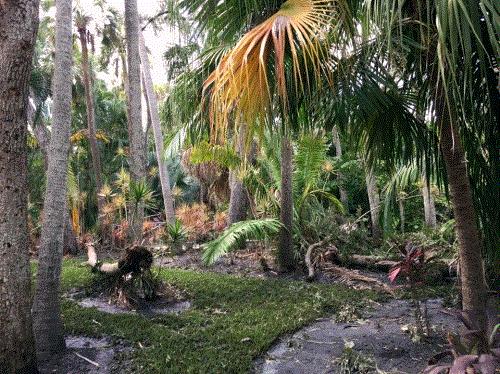
This is a typical damage level seen in landscapes in Central Florida northward into southern Georgia and South Carolina. Just a hot mess of debris and mud. Photo courtesy of FL Tech Botanic Garden.
Finally, from the Florida line northward through western Alabama, Georgia and South Carolina, there was damage that in many cases was a bit more severe compared to northern Florida. Why? Simply put, these areas don’t typically see winds in the 40- to 75-mph range sustained, so a lot of large deciduous trees not acclimated to high wind came down. Walking around the State Botanical Garden of Georgia, it's apparent that the primary targets were Quercus alba and Liriodendron tulipifera. There was also significant erosion to deal with. Nothing beats picking up sticks and shoveling muck on a Tuesday (and Wednesday and Thursday and …).
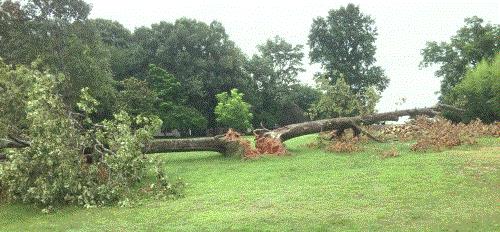
Moving further north into central and northern Alabama, Georgia, South Carolina and eastern Tennessee, damage looked like this, with many deciduous trees felled that were not structurally sound (no, double leader oak is not a good idea).
Enough with Southeastern Woes
Back in August, I wrote an article for GrowerTalks detailing some of the best woody ornamental breeders in the U.S. and trends that shape woody plant introductions. Naturally, I couldn’t document everything I spoke to the six plant breeders about in the GrowerTalks piece because my boss cut me off after three pages (I know… so inconsiderate!). But have no fear because my boss also (begrudgingly) allows me to write this newsletter!
One of the source for the GrowerTalks article was Dr. Mike Arnold. Mike is one of those academic folks (Texas A&M University) who “gets industry," and specifically, that plants need functionality so that industry can market them as unique. One trait that I have heard Mike speak of for years is salt tolerance. Now many of you may think, "What does salt tolerance have to do with me? I don’t live near the coast."
If you live in an area where it regularly snows and manage landscapes close to a road, you care. If you live in a coastal area, you care. If you live in a coastal area with saltwater intrusion into aquifers, you better care because that’s only getting worse (if you irrigate). That’s right … Mike saw the writing on the wall long ago and has been breeding and selecting for salt tolerance using mainly natives that he's tamed. Specifically, 40% of the U.S. population lives in a county that borders an oceanic coastline. That’s A LOT of market and it doesn’t even take into account residents of Syracuse and Buffalo who brew brine in their coffee pots to melt sidewalk ice in the winter.
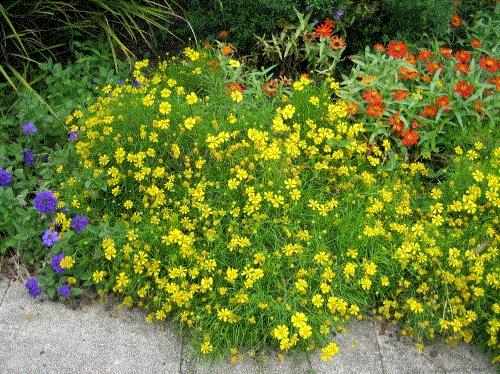
Helenium Dakota Gold is one of those tough natives that can take alkaline/saline soils quite well.
I must admit, Mike is either clairvoyant or darn good with a Ouija board. Nonetheless, with releases like Helenium Dakota Gold and a slew of Nerium oleander cultivars, including Cranberry Cooler, Grenadine Glace, Pink Lemonade, Pepermint Parfait, Raspberry Sherbert and Petite Peaches and Cream, he's positioned to capitalize on what's going to be an increasingly important landscape issue, which is salt tolerance.
Do you have any plants you want to throw out that have excellent salinity tolerance? If so, fire away!
Planning for Natural Disasters
Everyone should have a plan in place for natural disasters, be it hurricane, flood, tornado, fire or sudden death of a key individual. Funny enough, when I surveyed growers and landscape contractors back in 2009, 22% actually had a plan. That’s scary, folks.

Correctly planning for a disaster take a little forward thinking, which is apparently not required of city planners ... ly planning for a
So how do you develop a disaster management plan? There’s a two-part answer to this, with many moving parts within each. The first is the “natural disaster” component, whereby nearly every U.S. state has a Cooperative Extension publication, state office and federal offices to assist agricultural operations in receiving financial and physical aid. The best way to find those is by typing into a Google search “agriculture disaster resources” followed by your state. It’s always best to do this long before you see the event coming (or don’t see, in the case of earthquakes). It’s also a good idea to verify resources every six to 12 months, as government assistance programs can change from year to year.
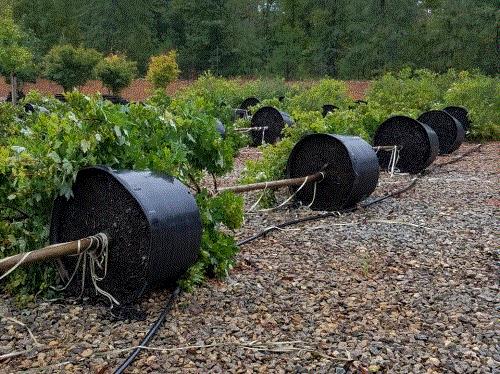
Planning doesn't have to be complicated. Pictured here at Diversified Trees, Inc, large containers are laid down with canopies pointed in the direction of the prevailing wind. Despite 50- to 60-mph winds, damage was minimal. Photo courtesy of Paul Chappell. lOO
s
The second part of this answer revolves around the “human disaster” component. Is there a succession plan in case a key individual quits, is terminated or dies? This happens far more frequently than anyone wants and yet is typically ignored because we as humans simply don’t want to think about negative events. Purdue University’s Community Development Department has by far (in my opinion) the best resource on succession planning and I suggest you check it out sooner rather than later.
Especially since the world is apparently ending tomorrow, September 23, 2017.
Boxwood Blight Best Management Practices Updated
Hot off the press from Jennifer Gray at AmericanHort comes the announcement that Boxwood Blight BMPs have been revised. They're proof that a lot can change in five years, especially when research receives the support needed to answer critical questions. Back in 2012, the U.S. nursery production world was still reeling from the discovery of boxwood blight the year prior. The Horticultural Research Institute (HRI) quickly established a fund dedicated to boxwood blight research and a boxwood blight working group composed of industry leaders and National Plant Board (NPB) representatives. A best management practices document for nursery production was produced out of this collaboration.
Subsequent research is still in progress, but enough new information exists to warrant a revision of the best management practices released back in 2012. AmericanHort and HRI, in conjunction with the NPB, are pleased to announce the revised, updated Boxwood Blight Best Management Practices, version 2.0.
Heat-Tolerant Kalmia, for Real?
As with every horticulturist who has left their cool and lush green landscapes of Zone 6 north and moved to the hellish gardening of Zone 8 south, you probably suffered through the same withdrawals to many of your Ericaceous friends as I did when I moved from Sweden to Virginia (shock number 1) and then Georgia (just ridiculous).
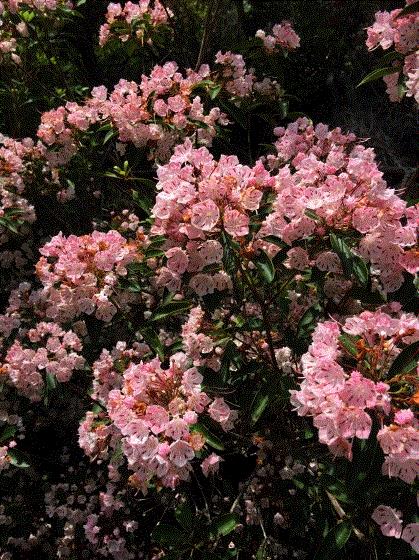
You southerners shouldn't listen to people who say you can't grow Kalmia latifolia. And you northerners may want to try southern selections, as they seem to have higher root rot tolerance. By the way, I took this picture in Mobile, Alabama (Zone 8b), of a native specimen.DD
One such plant I was told I would no longer be able to grow in my new Zone 8b landscape was Kalmia latifolia and I remember thinking, “Well, that just sucks.” But is that really true? Turns out, it was a big fat lie.
I've since discovered, and even have a graduate student working on, heat-tolerant Kalmia latifolia. We (in other words the graduate student) have over the last five years discovered native Kalmia populations as far south as Mobile, Alabama, and Columbia, South Carolina. The trick to growing Kalmia in the Southeast is selecting superior cultivars developed from these southern populations or finding a nursery that sells seedlings of southern populations.
There are a few of those out there. Woodlanders Nursery in South Carolina introductions include Croft Carpet, Pristine, Willowwood -- all of which do well across the south. Additionally, Dodd & Dodd Nursery sells seedling plants from plants collected in the Mobile area. Tom Dodd, many years ago, did release several cultivars, but I’m not aware that you can find them on the market today.
An interesting fact regarding southern Kalmia latifolia is that cultivars and seedlings from the south typically do fine north to Zone 5 (including the Midwest and West Coast) and they appear to have improved root rot tolerance. This just goes to show there's an exception to nearly every "rule" of nature and Kalmia is no different.
Our Wild and Wacky World – Notes from the Edge of Sanity
I like to string ideas and sections of the newsletter together, and so let me continue an interesting concept from above. It revolves around the idea of disjunct populations, which may sound like a complicated thing to understand, but it's not. A disjunct population is a group of plants of one species being geographically (physically) separated from the main species range. In the case of Kalmia latifolia, the southern populations are separated from the main (northern) species range by 50 to 250 miles, depending on where you look.
The question is, how did this happen? In the case of many North American species that have populations separated by hundred(s) of miles, the going theory is glaciation played a big part in this separation. While glaciers never reached Louisiana, Mississippi, Alabama, Georgia, South Carolina or the Florida panhandle, the climate absolutely changed, and as a result, pushed some species southward. There are dozens of what I like to call “gap species” that you find readily in zone 6, then not in zones 7 or 8a, and suddenly there they happily reside in Zone 8b or 9. This is especially true along major north-to-south flowing rivers, such as the Mississippi, Alabama, Chattahoochee, Savannah and Pee Dee. I’m sure the same would hold true for the southern Colorado River if it didn't flow into a desert and if it even flowed at all by the time it reached Mexico. Nonetheless, you do see the same principle hold true in the Southern Rockies, particularly along the northern Colorado and Green Rivers.
So what does this have to do with you? Well, it makes me think of two principles. First, when selecting a cultivar of a native plant check out where it was developed. If the cultivar was released from a breeding program in New York, chances it won’t do well in Florida. Second, for all the budding plant explorers out there … just remember that disjunct populations are possibly the last great untapped source of “cool plants” to be found in the wilds of North America. Happy hunting!
Live authentic,

Matthew Chappell
Editor-at-Large
Nursery & Landscape Insider
This has been received by 28,824 of the hardest-working horticulturists in show business!
If you're interested in reaching 28,824 (and growing) clients who eagerly await every Nursery & Landscape Insider and surely read every word, contact Kim Brown ASAP and she'll hook you up.